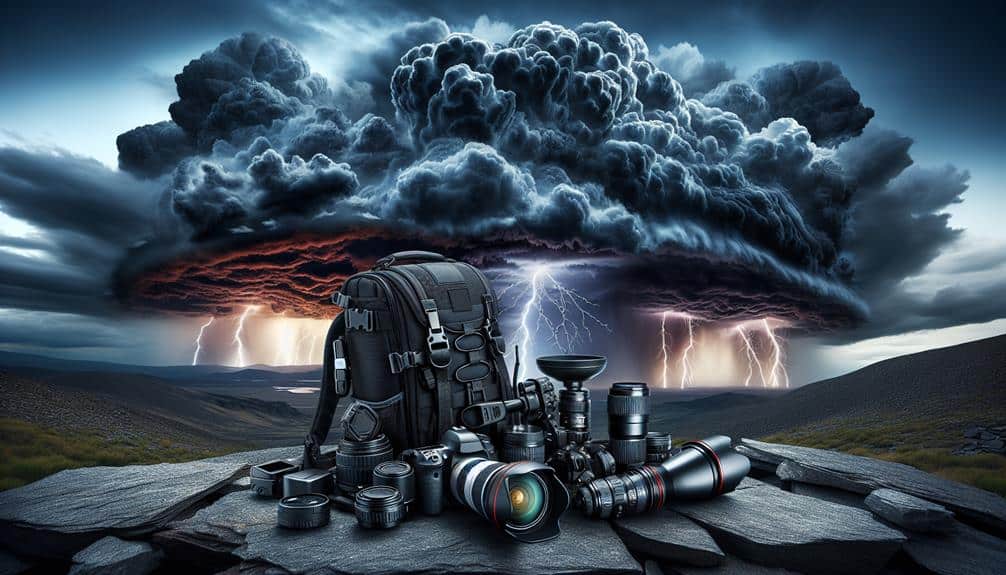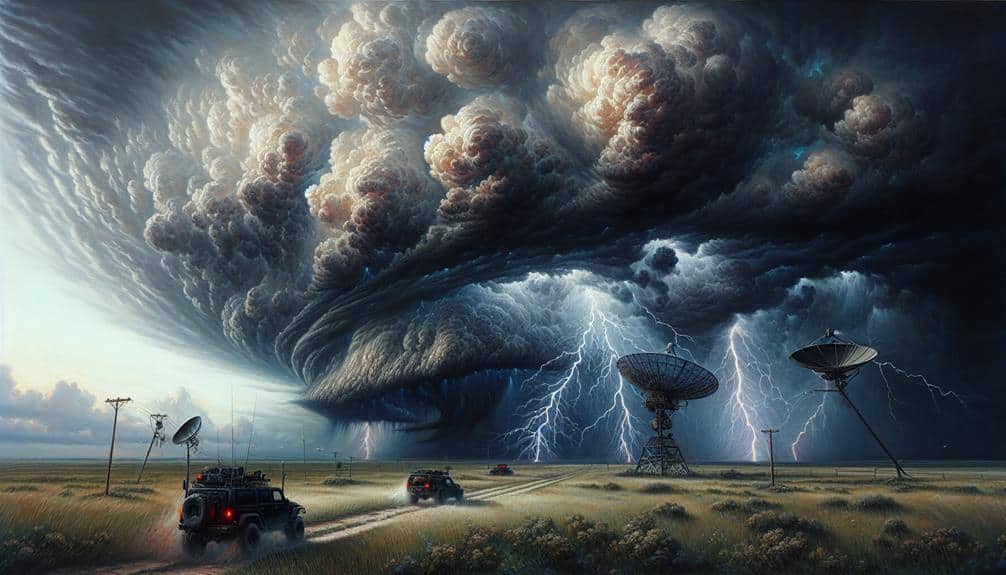When we prepare to intercept severe thunderstorms, we rely on essential gear for effective and safe tracking. First, a well-maintained vehicle ensures dependability, reducing breakdown risks. High-resolution weather radar systems help us analyze storm structures and predict paths. Robust communication devices, like satellite phones and walkie talkies, provide crucial updates and coordination. Safety gear, including emergency shelters and first aid kits, offers necessary protection in hazardous conditions. Finally, weather-sealed photography equipment, with RAW shooting capabilities and sturdy tripods, enables us to capture detailed storm images. For more insights on each gear and its importance, let's continue our exploration.
Key Points
- Ensure your vehicle is well-maintained with regular tire rotations, brake checks, and stocked emergency supplies.
- Utilize a high-resolution weather radar system with Doppler capabilities for detailed storm tracking and predictive modeling.
- Carry multiple communication devices like satellite phones and walkie talkies for reliable and redundant communication in remote areas.
- Equip yourself with safety gear including emergency shelters, lightning protection, and comprehensive first aid kits.
Reliable Vehicle
For storm chasers, a reliable vehicle is absolutely crucial to safely navigate the challenging conditions of severe thunderstorms. We can't emphasize enough the importance of thorough vehicle maintenance. Before heading out, we meticulously inspect tire tread, brake effectiveness, and fluid levels. These checks aren't just regular—they're vital to our safety and mobility in unpredictable weather.
We also give priority to stocking emergency supplies. Our vehicle carries a well-rounded kit: jumper cables, a flashlight, a first-aid kit, non-perishable food, and bottled water. A portable power bank guarantees our devices stay charged, while a multi-tool and rope can be invaluable if we encounter unexpected obstacles.
Data-driven decision-making guides our preparation. Historical data shows that vehicles in poor condition are more likely to face breakdowns in severe weather. As a result, our maintenance schedule is non-negotiable. We rotate tires every 5,000 miles and replace brake pads every 20,000 miles to ensure peak performance.
In addition to mechanical readiness, we acknowledge the freedom and confidence that come with being well-prepared. By maintaining our vehicle and equipping it with essential emergency supplies, we enhance our operational efficiency and make sure we can safely pursue the excitement of storm chasing.
Weather Radar System
Equipped with a reliable vehicle, we turn our attention to the essential weather radar system, which provides us with real-time data to track storm development and movement accurately. Radar technology is at the core of our storm tracking efforts, enabling us to gather vital information and make informed decisions while on the move.
A robust weather radar system offers:
- High-resolution imaging: Captures detailed storm structures, allowing precise tracking of thunderstorm cells.
- Doppler capabilities: Measures wind velocities within the storm, important for identifying rotation and potential tornado formation.
- Mobile integration: Guarantees seamless data access on the go, keeping us updated with the latest meteorological insights.
- Predictive modeling: Utilizes past and current data to forecast storm trajectories and intensities.
Utilizing these features, we can conduct rigorous data analysis to understand storm dynamics better. This level of detailed meteorological insight empowers us to predict severe weather patterns and intercept storms with greater accuracy.
Communication Devices
To maintain a continuous flow of important information during storm chases, we rely on an array of advanced communication devices. These tools are necessary for real-time coordination, accessing weather updates, and contacting emergency services if needed.
Our primary device is the satellite phone. Unlike regular mobile phones, satellite phones provide reliable communication in remote areas where cellular networks falter. This guarantees we're never cut off from essential weather updates or emergency contacts, regardless of our location.
We also use a walkie talkie system to maintain instant communication between team members. Walkie talkies are essential for short-range, immediate exchanges, especially when cell signal and satellite connectivity are compromised.
Additionally, we incorporate mobile data hotspots to enhance our connectivity options. These devices allow us to access live radar images, storm tracking tools, and weather updates from various meteorological sources.
It's important to have multiple communication methods to ensure redundancy and reliability.
Safety Gear
While dependable communication keeps us connected, our safety gear ensures we're protected in the field. When intercepting severe thunderstorms, having the right safety equipment is non-negotiable. Our primary concern is mitigating risks associated with extreme weather conditions, and this requires gear that guarantees both our physical safety and our ability to react swiftly to changing environments.
- Emergency shelters: These portable, durable shelters can be lifesavers when conditions deteriorate rapidly. They provide a quick refuge against hail, high winds, and other hazards.
- Lightning protection: Given the high incidence of lightning in severe storms, personal lightning protection devices and grounding techniques are essential to prevent strikes.
- First aid kits: Thorough kits equipped with supplies for treating injuries, including cuts, burns, and fractures, are critical for immediate medical response.
- Weather-appropriate clothing: High-visibility, waterproof, and wind-resistant gear guarantees we stay dry, visible, and shielded from the elements.
Investing in high-quality safety gear empowers us to navigate severe weather with confidence and agility, embracing the freedom to chase storms without compromising our well-being.
Photography Equipment

Capturing the raw power of severe thunderstorms demands high-quality photography equipment that can withstand harsh conditions and deliver sharp, precise images. First, we need a weather-sealed DSLR or mirrorless camera to protect against moisture and dust.
For camera settings, shooting in RAW format provides maximum flexibility during post-processing, while a fast shutter speed (1/1000s or faster) guarantees we freeze lightning and other fast-moving elements.
Lens selection is essential; a wide-angle lens (14-24mm) helps capture the expansive sky, while a telephoto lens (70-200mm) zooms in on specific details like lightning bolts or cloud formations. We should carry both to adapt to different scenarios.
Lighting techniques are crucial in storm photography. Using a tripod stabilizes our camera for long-exposure shots, essential for capturing lightning strikes. Additionally, a remote shutter release minimizes camera shake, securing sharp images.
Composition tips include positioning the horizon low to highlight the storm's magnitude and using leading lines (like roads or fences) to guide viewers' eyes into the scene.
Frequently Asked Questions
How Do You Identify the Best Locations for Storm Intercepting?
To identify the best storm chasing locations, we analyze weather models, radar data, and historical storm paths. Safety precautions are essential; we choose areas with clear escape routes and minimal population to guarantee our freedom and security.
What Is the Best Time of Year for Storm Chasing?
The prime time for storm chasing is spring, when weather patterns explode with fervor. We track supercells primarily from April to June, leveraging precise data on atmospheric conditions for ideal intercepts. Let's seize those stormy skies!
Are There Any Specific Apps Recommended for Tracking Severe Weather?
We've found RadarScope and Storm Shield to be excellent apps for tracking severe weather. They offer real-time weather radar and reliable emergency alerts, ensuring we're always informed and ready to chase storms safely.
What Kind of Insurance Should You Have for Storm Chasing Activities?
When dancing with nature's fury, we need thorough insurance coverage. Consider coverage options like liability, vehicle, and health insurance. Prioritize safety precautions and emergency preparedness to guarantee we're protected while embracing our storm-chasing freedom.
How Can You Stay Updated on Changing Weather Conditions During a Chase?
To stay updated on changing weather conditions during a chase, we use weather radios for 24/7 monitoring. We also follow social media updates from experienced storm chasers, ensuring real-time, precise data while maintaining our freedom on the road.


